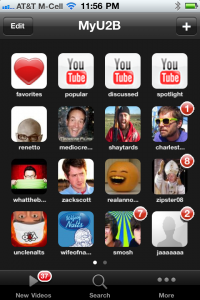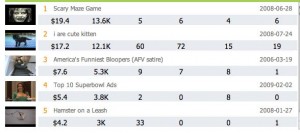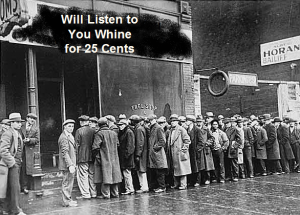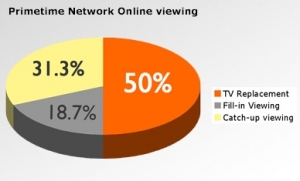Without bookmarks, RSS or e-mails, there are a few sites I remember and visit randomly. It’s usually because I’m bored or curious (but don’t know what I’m curious about). For instance, TechCrunch, Cheapskate, TheOnion, Google News, Yahoo Buzz. What are yours?
On TechCrunch I found an article about Blekko, a search engine that avoids spam by only indexing sites identified by people (like 2100 university sites). You use slashes to refine your search, so I tried Nalts and /date. That awakened me to a SocialTimes piece Megan O’Neill (Tel Aviv) curated a bunch of people and websites worth following on Twitter if you’re an online-video enthusiast. It’s quite handy, but I’m biased because I made the cut. 🙂
The Twitter accounts include ReelSEO’s Mark Robertson, GigaOM’s Ryan Lawler, Shape Shifting Zadi Diaz, as well as a bunch of people I consider “Friends” by a broad definition (meaning I have met them in person, I like them, and we share interests). Author Steve Garfield, Revisiond3’s Jim Louderback, Michael Buckley (WhatTheBuck), iJustine, Charles Trippy, Kassemg (the guy I know least among these). By a pure definition they’re not exactly friends, though. But isn’t the term “friend” changing because of Facebook’s use of the term?
Hey on that note, what’s a close friend? I’d consider a “close friend” someone you’ve known for a year or more, you’ve exchange meaningful information, and you know well and vice versa (meaning you each know your family/friends/significant others). For me, a friend isn’t competitive, they listen, and they share values. They can differ in many ways, but enjoy each other’s conversation and company. Most importantly, they forgive lapses in communication (something important to me because I’m spread thin and often vanish). I can think of dozens of people who are too frustrated by my intermittent communication to consider me a friend, and others who I can call after a long lapse and it’s like no time has passed.

Anyway, Megan also assembled a nice collection of online-video stats and news websites (these are her words below). I’d suggest adding a few sites sites like ViralBlog, ReelSEO, Urgo6667‘s stat site called Social Blade, and Renetto’s MyU2b).
- Unleash Video – Unleash Video is a video entertainment sharing website. On their Twitter account they tweet about videos and news from their website, but they also tweet about general news in the online video space and they always have something interesting to share.
- Web Series Today – If you enjoy web series then Web Series Today is definitely a must-follow. Web Series Today tweets about the web’s top video series and is the best source for unfiltered web series information online.
- Viral Video Chart – If you love being the first of your friends to know about the latest viral video hits then Viral Video Chart is the Tweeter to follow. Viral Video Chart tweets about all the latest and most popular viral videos on the web.
- Viral Viral Videos – Viral Viral Videos is also a great source, tweeting about viral videos as they go viral.
- Web Video News – Finally, Web Video News is a great source for online and web video news, research and trends, compiling news from a variety of different sources across the web.
My list of linked sites is somewhat arbitrary and antiquated, but I hope to revise it. Please let me know what else you read for news about online video, and I’ll try to refresh the list with these and others!






